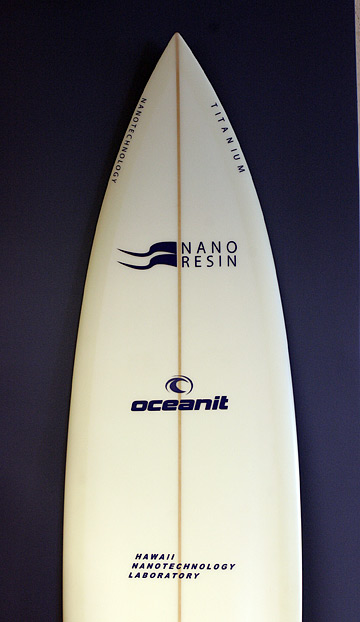Surfing a nano world
A Honolulu company creates a stronger surfboard resin to illustrate the benefits of nanotechnology
AS THE next big thing in high-tech materials, nanotechnology has found its way into a host of health and recreational products, from golf balls, tennis racquets and bicycles to sunscreen and cosmetics.
Now, a Honolulu company is applying nanotechnology to Hawaii's traditional pastime. Billing its product as a major improvement on standard materials, Oceanit Laboratories Inc. has created what its senior nanotechnology engineer, Vinod Veedu, calls the world's first nanotech surfboard.

FL MORRIS / FMORRIS@STARBULLETIN.COM
Honolulu's Oceanit Laboratories Inc. has developed what it thinks is the world's first nanotechnology surfboard. Tiny particles in epoxy resin coating the board make it stronger than normal epoxy resin without making it heavier.
|
|
The 8-foot board, designed for Oahu's North Shore, still hasn't been tested in the ocean because winter's big waves died out before the board was completed, said Ian Kitajima, Oceanit's marketing manager.
But Kitajima and Veedu seem confident that the board will ride as well as a traditional board. They also say nanotechnology makes it much stronger than a traditional foam-and-fiberglass board.
If the nanotechnology surfboard seems a little bit like a clever invention designed to grab the attention of the local community, it may be exactly that.
WHEN HE WAS a doctoral student at the University of Hawaii, Veedu and his professor, Mehrdad Nejhad, began working with Oceanit to come up with something that would connect with "the local market," Veedu said.
Veedu and Kitajima settled on the idea of the surf board.
Ian Wasnich, a mechanical engineer who once took a year-long sabbatical from Oceanit to shape surf boards, stepped in to craft the board.
The result, the product of about six months' labor, is a prototype with the same foam core and fiberglass cloth as a regular board. The difference lies in the resin that coats the foam and fiberglass.
This resin contains tiny particles of titanium that Kitajima likens to rebar in concrete -- only much, much smaller. In fact, the nanoparticles are only 20 nanometers long, or about 5,000 to 8,000 times thinner than a human hair. Although tiny, the particles give the boards a much tougher shell, or skin. According to Veedu, the board's skin is twice as resistant to dings and three times as resistant to fractures as that of a regular board.
The nanotech resin might cost just 30 percent more than standard resin, Kitajima said.
In common parlance and advertising speak, the term "nanotechnology" is often used to describe what used to be called "space-age material." Although the uses vary widely, with seemingly extraordinary potential, the technology often involves the manipulation of tiny particles to make new types of composites, such as plastics and cloth.
Mercedes-Benz has introduced a scratch-resistant nanotech clearcoat paint, for example. Wilson makes golf clubs using nanotech materials. Eddie Bauer markets fast-drying "water shorts" made with nanotech fabric. And Crown Laboratories claims to employ "the newest nanotechnological ingredients" in its Blue Lizard sunscreens.
SUCH A VERSATILE technology hasn't been overlooked by Oceanit, a technology R&D firm that has already spun off two other companies, medical device maker Hoana Medical and Nanopoint, a medical optics technology startup.
Since joining Oceanit a month ago, Veedu, who earned his doctorate in nanotech engineering, has been meeting with engineers from other Oceanit divisions to brainstorm new ways to use nanotech.
"I've been here a month and already we have 10 to 15 ideas," he said.
Among other things, Oceanit is looking to employ something that Veedu calls "nanoforest," which he developed at UH, to strengthen body and vehicle armor.
Veedu believes that Hawaii could build a nanotech industry cluster that will become a magnet for research and investment. Already, he said, the state has the UH Nanotechnology Laboratory. Plus, there's Oceanit, which has proven capable of attracting the venture investors needed to support startups. Finally, there is Hawaii's geographic location between the U.S. mainland, Japan and China, where much nanotech research is being done.
Veedu envisions nothing less than a nanotech equivalent of Silicon Valley.
"What we're trying to build is a Nano Valley," he said.
To help jump-start that development, Oceanit is teaming with UH to sponsor the 2006 Multifunctional NANOcomposites International Conference in September, a major industry meeting. Speakers will include Sir Harold Kroto, who was awarded a Nobel Prize for chemistry for his nanotechnology discoveries.
In the meantime, Oceanit will continue to work on its surfboard. The company is building a model to use in town, so it will not have to wait until winter to see how the board performs, Kitajima said. And with many surfers on staff at the company, there's no shortage of people willing to volunteer to test the 8-foot prototype.
The main challenge at this point, he said, is keeping people from playing with Oceanit's invention.
"We try to make sure that the board doesn't leave the office," Kitajima said.

